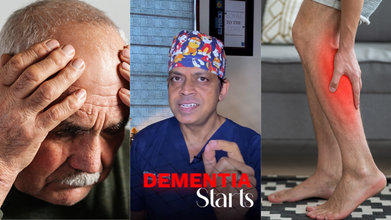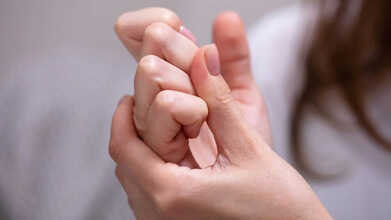- Health Conditions A-Z
- Health & Wellness
- Nutrition
- Fitness
- Health News
- Ayurveda
- Videos
- Medicine A-Z
- Parenting
- Web Stories
Tips To Avoid Germs And Infection This Autumn Season

Credits: Canva
Fall is a beautiful time of year, but it’s also when many viral illnesses peak. The cooler weather can weaken the immune system, increasing your vulnerability to infections, especially among children, the elderly, and those with weaker immune systems. Prevention is key to staying healthy, and with a few proactive steps, you can avoid germs and infections. Here's what to watch out for and how to protect yourself from common fall illnesses.
Common Fall Infections
Fall sees a surge in various viral and bacterial infections that spread easily in colder temperatures. Here are some of the most common ones:
Common Cold: The cold virus thrives in fall, causing runny noses, sneezing, congestion, and sore throats.
Flu: The flu season peaks in fall, with symptoms including fever, chills, body aches, and fatigue. If left untreated, it can turn into more serious illnesses like bronchitis or pneumonia.
Bronchitis: Caused by viruses, bronchitis inflames the airways in the lungs, leading to coughing, wheezing, and shortness of breath.
Sore Throat: Cooler weather can dry out your throat, making it more susceptible to infections. Sore throats can also be a symptom of allergies, colds, or the flu.
Ear Infections: These are more common in children but can affect adults as well. Ear infections are often caused by bacteria or viruses and can result from colds or allergies.
Allergies: Fall allergies, particularly from ragweed, mold, and dust mites, cause sneezing, watery eyes, and congestion. These allergens get stirred up as you turn on your heat for the first time in the season.
Now, let’s dive into some essential tips to help you prevent these infections and enjoy a healthy fall season.
Keep Your Hands Clean
Germs can linger on surfaces we touch throughout the day, such as doorknobs, phones, and countertops. Washing your hands frequently with soap and water for at least 20 seconds can dramatically reduce the chances of contracting or spreading harmful bacteria and viruses. In the absence of soap and water, use an alcohol-based hand sanitizer. Clean hands are one of the most effective ways to avoid infections like the flu and the common cold.
Strengthen Your Immune System
A strong immune system is your body’s first line of defense against germs. This fall, focus on boosting your immunity by eating a balanced diet rich in vitamins and minerals. Foods high in vitamin C (like oranges, bell peppers, and broccoli) and zinc (found in nuts, seeds, and beans) help fortify your immune response. In addition, regular exercise, adequate sleep, and managing stress are all key to maintaining a strong immune system.
Stay Hydrated
In cooler months, people tend to drink less water, which can affect the immune system. Staying hydrated helps flush toxins out of the body and keeps your mucous membranes in the nose and throat moist. This moisture makes it harder for germs to take hold and cause infections like colds or sore throats. Aim for at least eight cups of water daily and enjoy warm beverages like herbal teas to stay hydrated.
Disinfect High-Touch Surfaces
Cold and flu germs can live on surfaces for hours, so it’s crucial to regularly clean and disinfect high-contact areas such as door handles, countertops, and phones. Disinfectant wipes or sprays that target viruses and bacteria can help reduce the spread of infections in your home or workplace.
Get Enough Rest
Sleep is essential for a well-functioning immune system. When you’re well-rested, your body can fight off infections more effectively. According to studies, a lack of sleep weakens the immune response, making you more susceptible to illnesses like the flu or bronchitis. Adults should aim for 7-9 hours of sleep per night, while children and teens need even more. Create a calming bedtime routine to ensure restful sleep.
Avoid Close Contact with Sick People
As fall temperatures drop, people spend more time indoors, which makes it easier for germs to spread. Try to avoid close contact with people who are sick, and if you can’t, consider wearing a mask to protect yourself from respiratory infections. In crowded public spaces like buses or offices, it’s especially important to take precautions.
Keep Your Home Ventilated
Even though it’s tempting to keep windows closed during cooler months, proper ventilation is crucial for reducing the spread of airborne viruses and bacteria. Open your windows for a few minutes daily or use fans to ensure fresh air circulates throughout your home. This helps lower the concentration of germs indoors, reducing your risk of infections.
Why Do I Get Bad Dreams When I Am Sick?

Credits: Canva
What's worse than running nose, continuous sneezing, and a fever? It is the dreams you get when you have finally managed to put yourself to sleep, and those dreams are bad, scary, intense, and negative. Why does this happen?
What Is A Fever Dream?
A dream is basically a series of thoughts, images, sensations that you feel while you are sleeping, and scientists tell us that we have our strongest dreams during the rapid eye movement or the REM of the sleep stage.
Certain factors, including you health could influence your sleep visions and your dreams. A change in body temperature, especially when it is higher than usual could lead to a fever dream, which mostly could be intense, like a nightmare.
As per a 2016 study published in the International Journal of Dream Research, 94 per cent of participants described their fever dreams as negative. Another 2013 study noted that one of the participants had dreams that would move "back and forth between a very difficult circumstance and a very comfortable circumstance." A recent online study in 2020, published in the journal Frontiers Psychology noted that of the 164 participants, 100 of them reported fever dreams. Most of them said that fever dreams were more bizarre, and negatively toned.
While fever dream is known in the medical literature, the scientific studies on the same are limited. Many often describe this as an emotionally intense, troubling, strange, out of character, or a scary dream. The dreams could be the result of less social interactions due to someone being sick.
When Does A Fever Dream Happen?
A fever dream happens when the normal body temperature rises 2 degrees above. The normal body temperature is between 97 and 99 degree F. Anyone can develop a fever, due to the following conditions:
- a viral or bacterial infection
- heat exhaustion
- certain inflammatory conditions such as rheumatoid arthritis
- medicines, such as antibiotics
- an immunization
- a tumor
Why Do You Get Bad Dreams During Fever?
While there is no exact reasoning for it, the 2020 online study notes that the concept behind this is the 'over-heated' brain. High temperature of the body could disrupt the brain's normal cognitive functions. The authors of the 2020 study note, "The basic idea is that the ‘over-heated’ brain is not functioning properly and, therefore, dreams are more bizarre.”
During the REM stage of sleep, the phase where your most vivid dreams unfold, the body already struggles to regulate its internal temperature. When a fever strikes, it disrupts this delicate balance even further, often resulting in intense or disturbing dreams. Fevers can also stir the mind in other unsettling ways, sometimes causing waking hallucinations, irritability, or even brief episodes of confusion.
Dr Mark Rosenblum, who is a sleep psychologist with Hennepin Healthcare, tells CBS News that the reason behind intense dream during sickness is due to REM. He says, "If someone's not getting enough sleep, they get what's called REM rebound on the following nights. And when we have REM rebound, what we'll find is all our dreams tend to be very intense."
Are There Any Symptoms Of Fever Dreams?
As per a 2016 study published in the International Journal of Dream, fever dreams contain some sort of spatial distortion, that include:
- Moving walls
- Creatures with oversized arms and legs
- Metal spheres that move like an organism
- Blackness spreading slowly
- Gigantic insects
Dementia Starts In Your Legs, According To Doctor; What Are The Signs And Tips To Prevent It?

Credits: Instagram and Canva
Bengaluru based neurosurgeon Dr Arun L Naik dropped a video on his Instagram account @doclogues, which has shocked the world, because he says that 'Dementia Starts in Your Legs'.
As of now, most of us knew that it is a general term for a loss of thinking, and is part of normal aging and related to brain diseases that damage the nerve cell. However, Dr Naik notes that as per a 2020 study, it was found that those who walk in a slow speed, especially older adults, were more likely to face the risk of cognitive decline. "Why?" To this, Dr Naik writes that walking is not just a physical task, "it is a full brain workout".
Also Read: Can You Get Your Covid And Flu Shots At The Same Time? Experts Explain
How Is Walking Related To Brain Health? Can Lack Of It Cause Dementia?
Dr Naik writes that there exists a brain-leg connection. "Every step involves coordination between the frontal lobe, cerebellum, spinal cord, and proprioceptive feedback loops."
The second point he notes is of the circulation boost. He writes that leg movement improves blood flow to the brain, and it delivers oxygen, glucose, and clears out toxins.
Then comes gait changes, which the doctor says must be considered as brain warning. It is brain's way to tell that changes in walking style, balance, or pace could proceed to memory symptoms by years.
Lastly, he notes is the neuroplasticity in motion. He says that walking stimulates the brain-derived neurotrophic factor, which strengthens neuron connections. This is why, "weak legs can speed up cognitive decline," he says in his video.
What Study Is The Doctor Quoting When He Says That Dementia Starts From Leg?
The study is a 2020 review, which was published in the Journal of Aging Research. This is where it was seen that older adults, who stay physically active are less likely to develop cognitive decline or dementia. The study analyzed over 1,60,000 people and found that regular exercise reduced the risk of dementia by 28 per cent and Alzheimer's disease by 45 per cent.
With aging, especially from mid-50s, most adults begin to lose 1 to 2 per cent of muscle mass every year, this process is further accelerated by inactivity. This loss then not only affects mobility, but also metabolism and blood circulation, which results in less oxygen reaching to your brain, as the doctor also explained.
This is why the doctor says, "if your legs slow down, your brain may follow".
Can Something Be Done To Prevent Dementia?
The answer is yes. Dr Naik also says, "studies have shown that it is never too late to start. Starting even in your 60s can reduce dementia risk by a mile". So, what is he asking people to start? He is urging people to start some activity, to help their bodies move, and enable the brain to leg coordination.
The doctor also notes some "strategies" to prevent dementia in the caption of his post through movements, which are as followed:
- Walk 30 minutes daily at a brisk pace.
- Add balance exercises like tandem walking and single-leg stands.
- Practice dual-task walking (e.g. walking while talking or solving a simple mental task).
- Include strength training for lower limbs—muscle is cognitive insurance.
- Avoid long periods of sitting—movement every hour keeps memory sharp.
Fact Check: Does Cracking Your Knuckles Every Day Damage Your Joints?

Credits: Canva
If you are someone who cracks your knuckles every day just for that oddly satisfying pop, you are not alone. For many, the sharp sound brings a fleeting sense of relief or relaxation. Yet, there has long been a debate about whether this seemingly harmless habit could actually damage your joints or raise the risk of arthritis.
For those unversed, the pop you hear when cracking your knuckles comes from gas bubbles in the joint fluid collapsing. For most people, it’s harmless, though it can occasionally cause slight swelling or a temporary drop in grip strength. The long-standing belief that it leads to arthritis is not backed by science, but using too much force could result in minor injuries, like ligament sprains or dislocations
Addressing this common worry, orthopedic surgeon Dr. Manan Vora answered the question in a viral reel that has now surpassed 2.5 million views. A viewer asked him, “Can cracking knuckles every day lead to arthritis?”
Dr. Vora said, “The pop you hear when cracking a knuckle is the sound of these bubbles bursting within the synovial fluid inside the joint,” he clarified.
Is Cracking Knuckles Bad For You?
Knuckle cracking is a habit many pick up early in life, often because they enjoy the sound or the temporary feeling of looseness in the fingers. According to the Johns Hopkins Arthritis Center, the sound comes from changes inside the joint capsule, which is filled with synovial fluid. This fluid not only lubricates the joints but also nourishes the surrounding bones.
“A variety of gases are dissolved in this fluid. When a knuckle is cracked, stretching the capsule lowers the pressure inside, creating a vacuum. The dissolved gases form a bubble, which bursts, producing the familiar popping sound. It takes time for the gases to re-dissolve, which is why you can’t immediately crack the same knuckle again,” Johns Hopkins adds.
Does Cracking Knuckles Cause Arthritis?
Many worry that frequent knuckle cracking could trigger arthritis. However, research shows there is no evidence linking the habit to arthritis or long-term joint damage. A few reports have noted that excessive cracking may occasionally cause minor ligament strains or tendon dislocations, but these injuries typically heal on their own.
Some studies also suggest that habitual knuckle crackers might have slightly reduced grip strength over time, but this does not equate to arthritis. Rarely, “knuckle pads” can develop in young people who crack their knuckles often, but these are mostly cosmetic.
Several studies back up the conclusion that knuckle cracking does not cause arthritis. For example, a study by the Uniformed Services University of the Health Sciences followed 215 participants, 20% of whom regularly cracked their knuckles. They found arthritis in 18.1% of knuckle crackers and 21.5% of non-crackers, essentially the same rate, showing no link between the habit and the disease.
A famous anecdote comes from Dr. Donald Unger, who cracked the knuckles on his left hand twice daily for 50 years while leaving his right hand untouched. Published in Arthritis and Rheumatism in 1998, the informal experiment revealed that neither hand showed signs of arthritis. More recent studies in 2017 reached similar results, finding no difference in hand function between people who cracked their knuckles and those who didn’t.
What Is Arthritis?
Arthritis is a condition that causes inflammation and pain in one or more joints, often leading to stiffness and limiting the joint’s range of motion. Genetics play a major role, with environmental triggers contributing to inflammatory types, and age or mechanical stress driving degenerative arthritis.
Other risk factors include obesity, previous joint injuries, family history, older age, and being female. But as research confirms, knuckle cracking is not one of them.
© 2024 Bennett, Coleman & Company Limited

